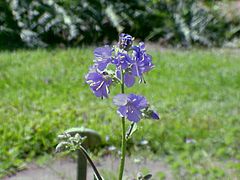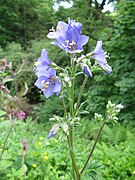| Polemonium caeruleum | |
|---|---|

| |
| Scientific classification | |
| Kingdom: | Plantae |
| Clade: | Tracheophytes |
| Clade: | Angiosperms |
| Clade: | Eudicots |
| Clade: | Asterids |
| Order: | Ericales |
| Family: | Polemoniaceae |
| Genus: | Polemonium |
| Species: | P. caeruleum |
| Binomial name | |
| Polemonium caeruleum L. | |
| Synonyms | |
| |
Polemonium caeruleum, known as Jacob's-ladder or Greek valerian, is a hardy perennial flowering plant. The plant produces cup-shaped, blue or white flowers. It is native to temperate regions of Europe. It is the type species of the phlox family, Polemoniaceae.
Growth
The plant usually reaches 45–60 cm (18–24 in) tall and broad, but some occasionally grow taller than 90 cm (35 in). It can grow in North American hardiness zone 2.
Habitat
The plant is native to damp grasslands, woodlands, meadows and rocky areas in temperate areas of Europe and Asia.
Cultivation
The plant normally prefers soil that is rich in moisture and lime with partial shade. Normally hardy, some cultivars (e.g. 'Blue Pearl') behave as tender biennials, which means they are effectively annuals in cooler climates (below hardiness zone 6).
The plant is known to have a few landscape uses as well such as attracting beneficial insects. The plant itself is convenient for container planting due to the shape of its growth. The flower may be presented as a cut flower or foliage and may be added to bouquets for its pleasant smell. It can be grown in a perennial border or rock garden.
Cultivars include:
- 'Album' (white flowered)
- 'Blue Pearl'
- 'Brise d'Anjou'
- 'White Pearl' (white flowered)
- 'Snow and Sapphires' (variegated foliage)
The plant does not have serious insect or disease problems. Leaf spot and powdery mildew can be problems, particularly in humid climates. The foliage may scorch if the plant gets too much sunlight. The leaflet tips will brown up if soils are allowed to dry out. The foliage will generally decline and become less attractive as the summer progresses. It is important to keep an eye out for slugs.
Other uses
Polemonium caeruleum was voted the county flower of Derbyshire in 2002 following a poll by the wild plant conservation charity Plantlife.
References
- The Plant List: A Working List of All Plant Species, retrieved 11 May 2016
- BSBI List 2007 (xls). Botanical Society of Britain and Ireland. Archived from the original (xls) on 2015-06-26. Retrieved 17 October 2014.
- ^ "Polemonium caeruleum". Missouri Botanical Gardens. Retrieved 10 November 2016.
- "School of Horticulture Plant Database". Kwantlen Polytechnic University. Retrieved 10 November 2016.
- "'Snow & Sapphire' Variegated Jacob's Ladder". Paghat the Ratgirl. Retrieved 11 May 2016.
- Howard, Doreen G. (2006). "From Backyard to Big Time" (PDF). The American Gardener. 85 (6). American Horticultural Society: 17. Retrieved 10 May 2016.
- "County Flowers". Plantlife. Archived from the original on 6 August 2013. Retrieved 19 August 2013.
External list
- Biggs, Matthew, Vegetables, Herbs & Fruit: An Illustrated Encyclopedia, (2006) p324-325. Firefly Books Ltd., ISBN 1-55407-126-7
- Bremness, Lesley, Herbs (Smithsonian Handbooks), (1994–2002) p205. Dorling Kindersley, Inc., ISBN 0-7894-9391-8
- Howes, F.N., Plants and Beekeeping, (1979) p161 Faber Paperbacks, ISBN 0-571-11358-3
| Taxon identifiers | |
|---|---|
| Polemonium caeruleum |
|



